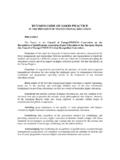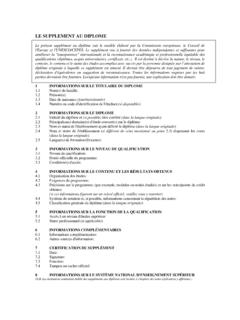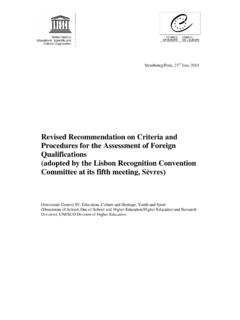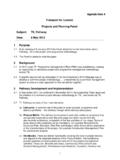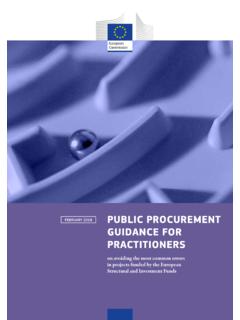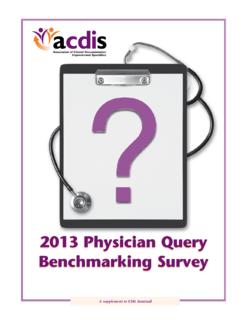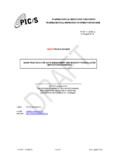Transcription of SQUARE Protocol FIN - Enic-Naric
1 SQUARE Self-evaluation and Peer Review Protocol March 2016 This Protocol describes the quality assurance mechanism developed within SQUARE , the System of Quality Assurance for the Recognition Networks' project. This tool is primarily designed to benefit your Enic-Naric centre, to improve your centre's practice following the international criteria of the LRC and taking into account your centre's specific mandate. The SQUARE quality assurance mechanism should be regarded as a voluntary exercise. This document explains how to complete the self-evaluation and the peer review. The SQUARE instruments The SQUARE quality assurance mechanism is based on two parts: 1- A self-evaluation tool for ENIC-NARICs to enable an Enic-Naric centre to objectively assess their recognition practice according to a set of Standards & Guidelines that are based on the Lisbon Recognition Convention (LRC), the EAR manual and the joint Enic-Naric Charter; 2- A peer review mechanism, involving external experts who will review your centre based on your self-evaluation.
2 You should consider the self-evaluation to be an internal information gathering, critical reflection and analysis on the policies, processes and procedures of your centre, and the peer review as an external assessment of your organization/unit carried out by external reviewers. You could compare the self-evaluation with an internal audit and the peer review as an external audit. Background The Enic-Naric networks base their work on several key documents that provide recommendations for good practice: The Convention on the Recognition of Qualifications concerning Higher Education in the European Region (also known as Lisbon Recognition Convention, Council of Europe and UNESCO 1997) and its subsidiary texts provide the legal grounds for recognition policy and practices . In 2004 the joint Enic-Naric charter outlined the terms of operation of the ENIC- NARIC networks including the tasks, activities, resources, level of expertise and staff requirements. The European Area for Recognition (EAR) manual, based on the Lisbon Recognition Convention, outlines good practice for international recognition and provides clear recommendations for fair recognition of qualifications.
3 The manual was 1. published in January 2012 and in April 2012 its use was endorsed in the communiqu of the Bucharest Ministerial EHEA Conference. SQUARE enables ENIC-NARICs to assess the extent to which they work according to this internationally agreed good practice, and to improve their practice where needed. As such SQUARE contributes to fair and smooth recognition and towards further cooperation in the recognition area. 2. Part 1 - Self-evaluation The self-evaluation is developed to enable ENIC-NARICs centres to critically reflect to which extend they comply with the good practice agreed upon within the networks, and to improve where necessary and to enhance where possible. The self-evaluation tool is intended to help analyse your current practice, identify strengths and weaknesses and suggest the action points needed to improve the quality of your centre. Below you will find: A description of the self-evaluation tool; Instructions on how to undertake the self-evaluation.
4 The self-evaluation tool consists of: 6 standards and guidelines to evaluate your Enic-Naric centre; A template to perform a short SWOT analysis. 1. Description of the self-evaluation tool The self-evaluation tool consists of two steps: 1. Analysis of compliance with the standards and guidelines for good practice The purpose is to gather data, reflect and establish the extent to which the existing practices and procedures of your centre comply with the standards and guidelines for good practice. These standards are based mainly on the EAR Manual, combined with some elements of the Enic-Naric Charter. 2. A short Strengths Weaknesses Opportunities and Threats (SWOT) analysis The aim of the SWOT analysis is to enable your centre to indicate its strengths, weaknesses and areas for improvement, and furthermore to formulate action points for the near future. Depending on the situation, your centre might opt to only perform the first part of the self-evaluation, which would result in documentation and verification of your compliance with the standards and guidelines.
5 The second part (the SWOT analysis) would result in a critical self-assessment of your centre's recognition practice, leading to an action plan to improve the performance of your centre. It is highly recommended to conduct both parts of the self-evaluation. Frequency Both steps can be completed regularly providing your centre with a robust and evidence-based internal quality assurance system. In general it is recommended to conduct the self evaluation every 3 to 5 years. However, this timeframe can change depending on: 3. Goals set in a previous SWOT analysis or action points resulting from a peer review. Depending on the time needed to complete those goals, one can decide on the appropriate time to conduct the next self-evaluation. A change in mandate of the centre. If your mandate is going to change, you might postpone the next self-evaluation until you have gained sufficient experience with the new processes and procedures. 2. How to complete the self-evaluation tool?
6 It is advisable to involve various members of your centre into the self-evaluation, preferably a combination of at least one employee who is active in the primary process of your centre (information provision and/or the evaluation process) and at least one manager and/or the head of office. The total number of staff involved in the self-evaluation should reflect the total number of staff and variety of tasks of your centre. It will take approximately one to three working days to complete the full self-evaluation. Please notice that you might need to spread the hours over several days. - Step 1 Compliance to standards Part 1 of the self-evaluation consists of 6 standards (annex 2), including a text-box with guidelines on how to comply with each of the standards: 1. Procedures, Criteria and Quality Assurance 2. Applicant-centred Recognition 3. Quality, Legitimacy and Authenticity 4. Evaluation Tools and Resources 5. Transparency and Information Provision 6. (Inter)national Cooperation and Presentation Relevance of the standards and level of compliance may be influenced by the role and remit of individual centres.
7 Therefore, before doing the self-evaluation, the centres are invited to complete the typology form (see annex 1). Describing compliance to standards You will be asked an open question to elaborate on how your centre complies with each of the standards, taking into account the specific issues raised in the guidelines accompanying the standards. This has several functions, it: is the basis upon which you rate your overall compliance to the standard (see following paragraph); gives you the opportunity to describe your practice in relation to the standard, which forms valuable input for the second part of the self-evaluation (the SWOT analysis); is very useful to review this information the next time your centre is going to fill in the self-evaluation tool, to see whether your practice has improved or whether the circumstances under which your centre operates have changed (see also frequency section above). 4. For a few standards, it is explicitly requested to provide evidence for how the standard is met.
8 If this is the case the text is highlighted in yellow. Please note: You are strongly encouraged to also include this type of evidence to support your description of compliance to other standards. Apart from including physical examples, this also can also be done by referring to practice(s). Especially when you aim to undertake a peer review of your centre, providing evidence is crucial as the peer review team may ask you to support your statements with this type of evidence. These support documents are very useful for future reference and therefore you are advised to keep them on file (hard copy or electronic). Further note that one document ( a copy of your standard evaluation form) may contain evidence for more than one standard. Rating compliance to standards After describing and analysing your compliance, you are expected to indicate to which extent your centre complies with the standard on a scale from one to four: 1. No compliance The centre fails to comply with the standard.
9 2. Partial compliance Some aspects or parts of the standard are met, while others are not. The interpretation of the standard is correct, but the manner of implementation is not effective enough. 3. Substantial compliance The centre is to a large extent in accordance with the standard, the spirit/principle of which is followed in practice. 4. Full compliance The centre acts entirely in accordance with the standard, and its implementation is effective. Step 2 - SWOT analysis Part 2 of the evaluation tool consists of the SWOT analysis, for which a template is provided (see annex 3). A SWOT analysis is a structured method to evaluate the Strengths, Weaknesses, Opportunities, and Threats of an organisation. It involves specifying the objectives of the organisation and identifying the internal and external factors that are favourable and unfavourable to achieving those objectives. In a SWOT analysis you should investigate two things: is your compliance to a particular standard mainly influenced by internal or external causes?
10 Are these causes helpful or harmful to achieving your objectives? 5. By combining these two answers, you will find out if that particular standard represents a strength, weakness, opportunity or threat for your centre (see table below) It may be wise to prioritize the standards which you feel are most important for your centre before undertaking the SWOT, in order to make the SWOT analysis as relevant as possible and not too extensive. Action points As a result of this analysis you formulate action points in order to convert internal weaknesses of your centre into strengths, and external threats into opportunities. On the other hand, strengths and opportunities that already exist at present may lead to action points that enable your centre to capitalize on them. The analysis itself should be no longer than two pages and the action points should be clearly formulated. Example of a SWOT analysis Your centre has scored quite low (2 partial compliance) on standard 2 (procedures, criteria and quality assurance).
